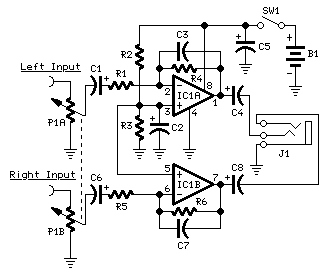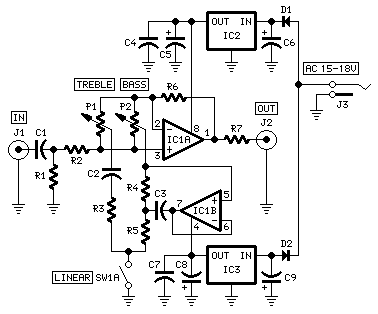Wednesday, November 30, 2011
uA 741-Square Wave Generator
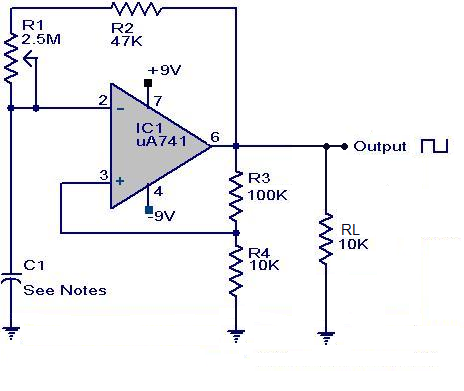
A square wave generator with IC UA741 range shown here.The circuit uses positive feedback to the Schmitt trigger action and negative feedback to measure the time of the waveform.
Let us assume that the output is high and the capacitor C1 is fully discharged.C1 now begins to charge through R2 and C1 R1.When tension rises above the junction of R3 and R4, the output changes rapidly totally negative voltage.C1 Now begins the unloading and reloading in the direction.Again contrast, when the negative voltage across C1 falls below that at pin 3, the circuit is returned quickly to totally positive repetitions value.The output endless cycle.
The square wave frequency can be varied by varying POT R1.The frequency range of the circuit depends on the value of R3, R4 and C1.
Let us assume that the output is high and the capacitor C1 is fully discharged.C1 now begins to charge through R2 and C1 R1.When tension rises above the junction of R3 and R4, the output changes rapidly totally negative voltage.C1 Now begins the unloading and reloading in the direction.Again contrast, when the negative voltage across C1 falls below that at pin 3, the circuit is returned quickly to totally positive repetitions value.The output endless cycle.
The square wave frequency can be varied by varying POT R1.The frequency range of the circuit depends on the value of R3, R4 and C1.
Monday, November 28, 2011
9V Portable Headphone Amplifier
After several requests of the correspondents, the decision to design a headphone amplifier 9V power was finally taken. The main requirement was to feed the circuit by a common, PP3 (transistor radio) alkaline batteries. Therefore, the circuit implementation of a low current draw was absolutely necessary, while retaining high quality.
The emergence of low-noise 5534 operational amplifier at a reasonable price was much appreciated by audio designers. Now it is difficult or impossible to design a specific phase that has the performance of 5534, without the complexity unacceptable. 5534 operational amplifiers are available from various sources, in a conventional 8-pin dil format. This version is internally compensated for gains of three or more, but requires a small external capacitor (5-15pF) for unity gain stability. The 5532 is a convenient pack of two 5534s in an 8-pin device with internal unity gain compensation, since there are no spare pins.
The 5534 / 2 is a low distortion and low noise device also has the ability of low-impedance load to full voltage swing, while maintaining low distortion. It is fully output short-circuit. Therefore, this circuit is carried out with a single 5532 chip forming a pair of stereo amplifiers, invest, have a current gain of about 3.5 alternating and capable of delivering up to 3.6 V peak to peak 32 Ohm load (corresponding to 50mW RMS) less than 0.025% total harmonic distortion (1 kHz and 10 kHz).
Considering that the average current drawing a power of 15 mW per channel is about 12-13mA (both channels driven), this headphone amplifier will become a "must" for many DIY enthusiasts who need a device High quality, high performance laptop.
Sunday, November 27, 2011
Preamplifier Bass and Treble Controls
Need a tone control, this module can be inserted into the chain between the Control Center and power amplifier. The circuit is based on an original design by Reg Williamson, published in Electronics World + Wireless World, circuit ideas, January 1991.
The tone control circuit will take the form of any of the traditional low treble adjustment, or the type of shelves, which is similar to a "tilt" control, but with separate bass and treble. Asymptotic slopes for both are about 4dB/octave, but begin to level off at 100 Hz and 10 kHz, with a maximum of ± 15 dB at the ends of the audio band.
Component values in parentheses are the shelving of control. In this case, the platform starts around 250 Hz and 4 kHz, flatten to a maximum of ± 6dB an octave above or below the central point is 1 kHz. Reactive elements for low-end includes a generalized impedance converter, which simulates an inductor in series with a resistor (spinner).
When set to the centers of their respective electrical controls, equalizers reactive elements are almost out of circuit. With these settings, the circuit behaves as a unity gain amplifier with 100% negative votes. Still, the reactive elements can be changed completely with a DPST on / off.
As with the other modules in this series, each electronic card can be fitted in a standard: Hammond extruded aluminum cases are well suited to accommodate the tables in this preamp. In particular, instances of size 16 x 10.3 x 5.3 cm or 22 x 10.3 x 5.3 cm look very good when stacked. See below an example of the possible arrangement of the front and back of this module.
Saturday, November 26, 2011
150W LM12 Audio Amplifier
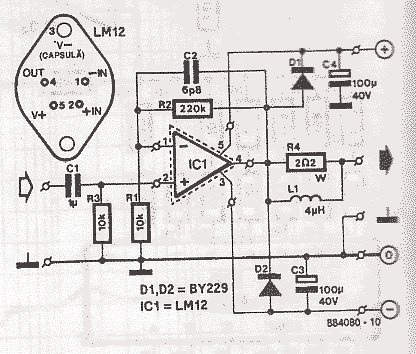
LM12 operational amplifier can output currents up to 10A. The LM12 in encapsulated in TO-3 with 4 pins, can support up to 800W and has enough internal protections to prevent slacks from over-currents or over-heating.
You can use LM12CL with 30 V maximum voltage or LM12C with 40V maximum. The L1 coil has 40 turns 1mm copper, coiled over R4. If you use LM12CL it is recomended to have toroidal transformer 2 x 22V. The output must be between 7 and 12A. Filtering capacitors must have at least 20.000 uF. LM12 must be mounted with screws on a big heatsink (=< 1.50 C/W) and electric isolated form the heatsink.
via: electroschematics.com
You can use LM12CL with 30 V maximum voltage or LM12C with 40V maximum. The L1 coil has 40 turns 1mm copper, coiled over R4. If you use LM12CL it is recomended to have toroidal transformer 2 x 22V. The output must be between 7 and 12A. Filtering capacitors must have at least 20.000 uF. LM12 must be mounted with screws on a big heatsink (=< 1.50 C/W) and electric isolated form the heatsink.
via: electroschematics.com
Friday, November 25, 2011
200M FM Transmitter Simple Circuit
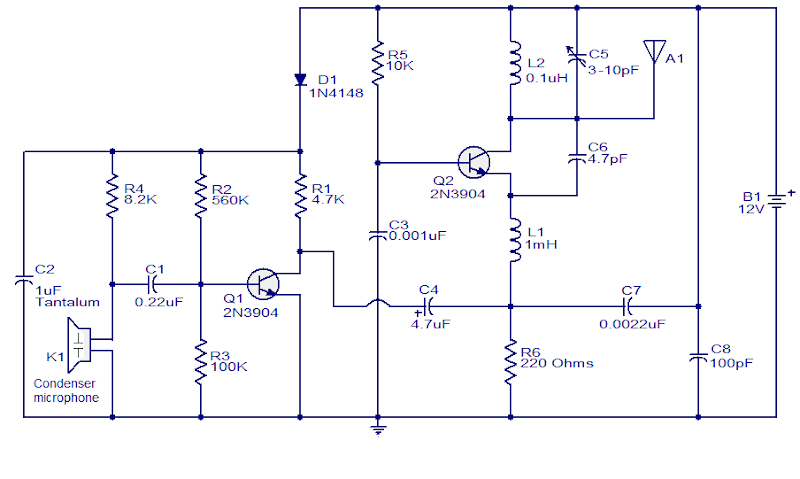
FM transmitter circuit very stable and simple given here. With an adaptive antenna, the transmitter can reach a range of about 200 meters. Transmitter met this year and got a few good results. Let's see how the circuit.
A condenser microphone (K1) is used to collect the sound transmitted. The capacitor C1 is a DC decoupler and the audio signal is coupled to the base of Q1 which connects a preamplifier.R2 and R3 are the resistances of polarization of Q1. Amplified sound signal will be available at the collector of Q1 and, together with the emitter of transistor Q2 through capacitor C4 and inductor L1 1mH.
C4 capacitor decouples the DC component of the preamplifier output. Q2 does the work of the oscillator and modulator. Inductor L2 and capacitor C5 variable tank circuit is necessary to create oscillations. Capacitor C6 is the feedback capacitor. The FM modulated wave will be available at the collector of Q1 and is transmitted through the antenna A1.
A condenser microphone (K1) is used to collect the sound transmitted. The capacitor C1 is a DC decoupler and the audio signal is coupled to the base of Q1 which connects a preamplifier.R2 and R3 are the resistances of polarization of Q1. Amplified sound signal will be available at the collector of Q1 and, together with the emitter of transistor Q2 through capacitor C4 and inductor L1 1mH.
C4 capacitor decouples the DC component of the preamplifier output. Q2 does the work of the oscillator and modulator. Inductor L2 and capacitor C5 variable tank circuit is necessary to create oscillations. Capacitor C6 is the feedback capacitor. The FM modulated wave will be available at the collector of Q1 and is transmitted through the antenna A1.
Wednesday, November 16, 2011
170W Audio Power Amplifier With LM4651&LM4652

The combination of controller IC LM4651 and LM4652 Class D MOSFET power amplifier IC power amplifier solution provides a high efficiency, suitable for powered speakers, subwoofers and amplifiers car quality.
The LM 4651 is a fully integrated conventional pulse width modulator (PWM) driver, which contain low-voltage circuit, short, overshoot, and thermal shutdown circuit protection. The IC has a standby function which shuts the pulse width modulation, minimizing the current bid.
The LM 4652 is a fully integrated H-bridge power MOSFET IC in a TO220 power pack. The IC has a temperature sensor to alert the LM4651 when the die temperature exceeds the threshold limit.
Used together, LM4651 and LM4652 as a simple, compact, efficient, high quality audio power amplifier complete solution for protection, usually seen only in class AB amplifiers.
The maximum efficiency of this circuit is 85% to 125 W with an expected attenuation of greater than 100 dB. The THD at 10W, 4 ohm, 10 - 500 Hz max. 0.3%. The supply voltage can not exceed ± 22V.
The LM 4651 is a fully integrated conventional pulse width modulator (PWM) driver, which contain low-voltage circuit, short, overshoot, and thermal shutdown circuit protection. The IC has a standby function which shuts the pulse width modulation, minimizing the current bid.
The LM 4652 is a fully integrated H-bridge power MOSFET IC in a TO220 power pack. The IC has a temperature sensor to alert the LM4651 when the die temperature exceeds the threshold limit.
Used together, LM4651 and LM4652 as a simple, compact, efficient, high quality audio power amplifier complete solution for protection, usually seen only in class AB amplifiers.
The maximum efficiency of this circuit is 85% to 125 W with an expected attenuation of greater than 100 dB. The THD at 10W, 4 ohm, 10 - 500 Hz max. 0.3%. The supply voltage can not exceed ± 22V.
Wednesday, November 9, 2011
LM358N - DEW Sensor
The following schematic shows a simple DEW sensor circuit diagram using LM258N IC. As the humidity around the circuit goes up, the resistance in the DEW sensor increases. When the resistance reaches a pre-specified level, the circuitry displays a warning message, and shuts down the external device
 |
| LM358N - DEW Sensor |
Under normal conditions, resistance of the dew sensor is low (1 kilo-ohm or so) and thus the voltage at its non-inverting terminal (pin 3) is low compared to that at its inverting input (pin 2) terminal. The corresponding output of the comparator (at pin 1) is accordingly low and thus nothing happens in the circuit.
When humidity exceeds 80 per cent, the sensor resistance increases rapidly. As a result, the non-inverting pin becomes more positive than the inverting pin. This pushes up the output of IC1 to a high level. As a consequence, the LED inside the opto-coupler is energised.
At the same time LED1 provides a visual indication. The opto-coupler can be suitably interfaced to any electronic device for switching purpose. Circuit comprising diode D2, resistors R5 and R6 and capacitor C1 forms a low-voltage, low-current power supply unit. This simple arrangement obviates the requirement for a bulky and expensive step-down transformer.
TGS813 Gas Alarm
This toxic gas alarm circuit is sensitive to less than 100 ppm of carbon monoxide. This alarm is useful for simple gas boats, sheds and cabins. You could save a life. Some of the companies listed in the Appendix to offer plans and kits for various toxic gas sensors.
Alarm of toxic gases it utilizes a tin-oxide-semiconductor. A coil of thin wire heated by a battery 12 V via IC1 and IC2, the which pulses the voltage to the coil of the sensor, saving a significant amount of energy. Zener diode Dl provides a constant voltage to the filament coil sensors. resistance of the sensor reduces the sensor is exposed to toxic gases Such as hydrogen, carbon monoxide and propane. Reduced to the resistance of the sensor, the SCR gate voltage increases. When the gate threshold voltage is reached, the SCR fires and a buzzer alarm is activated. Once activated, the bell and the switches S1 Should Be used to reset the alarm. Since the sensor has a good deal of thermal inertia, S1 must be off or open for about three or four minutes after the initial activation, allowing the sensor to stabilize, thus avoiding false alarms. Sensitivity control R7 set to the Desired value, before the activation of the SCR.
for more details about TGS813 Gas Alarm Circuit please visit http://www.free-circuit.com/toxic-gas-detector-and-alarm-circuit-with-tgs813/
Friday, November 4, 2011
Stereo Amplifier Circuit with BA5406
In the this circuit diagram, BA5406 is configured to deliver 5 x 2 watts at 4 ohm speakers to a supply voltage of 9 volts. The capacitor C3 is a power supply filter capacitor. C11 and C12 are decoupling capacitors DC input for the left and right. C3 and R2 form a Zobel network to output the left, while C6 and R3 is the same for the right channel.
Zobel network purpose is to reduce vibrations and improve the high frequency stability of the amplifier. Potentiometers R5 and R6 serves as a volume control for left and right channels. C8 pair CapacitorsC4 and the amplifier outputs to the speakers. C9 and C10 are the noise filtering capacitors. C1 and C5 are starting capacitors for left and right channels.
Zobel network purpose is to reduce vibrations and improve the high frequency stability of the amplifier. Potentiometers R5 and R6 serves as a volume control for left and right channels. C8 pair CapacitorsC4 and the amplifier outputs to the speakers. C9 and C10 are the noise filtering capacitors. C1 and C5 are starting capacitors for left and right channels.
Notes.
- BA5406 requires a proper heat sink.
- Supply voltage range is 5 to 15V DC.
- I used 9V DC for powering the amplifier.
- The power supply must be well regulated and filtered
Subscribe to:
Comments (Atom)
